
* Airbus Industries, a European multinational collaboration, emerged from the late 1960s, with a goal to develop jetliners that could compete on an equal basis with US giant Boeing. The first Airbus effort was the "A300", a double-aisle "widebody" jet, that led to the short "A310" and stretched "A330 / A340" derivatives. Having launched the A300 widebody, Airbus then went on to develop a single-aisle "narrowbody" jetliner, which emerged as the "A320", leading to the short "A319" and "A318", and stretched "A321".
From the late 1990s, Airbus further diversified to come up with the "A380" double-deck "superjumbo" jetliner. The company later introduced the advanced-technology "A350" to replace the A300 series, and obtained a "regional jet", the "A220", from Bombardier of Canada. This document provides a history and description of the A220, A320, A350, and A380. A list of illustration credits is provided at the end.
* Airbus Industries arose in the late 1960s and the early 1970s as a multinational European collaboration to develop jetliners that could compete on an equal basis with US giant Boeing -- at the time the overwhelmingly dominant player in the jetliner business. The first Airbus effort was the "A300", a double-aisle "widebody" jet, that proved commercially successful after an initial period of difficulty. The A300 led to the short "A310" and stretched "A330 / A340" derivatives.
From early on, Airbus also wanted to build a narrow-body / single-aisle (SA) series of jetliners, primarily to compete with the US Douglas DC-9 and in particular Boeing 737, following in the path of the relatively successful British BAC One-Eleven. After consideration of a range of preliminary design concepts for the SA, the program to develop the initial narrow-body jetliner, the "A320", was formally launched in 1984, with first flight on 22 February 1987, and first deliveries the next year. Air France was the launch customer.
* As it emerged, the A320 was of conventional overall configuration, being a low-wing design, made of aluminum alloy with considerable use of composite materials, featuring all-swept flight surfaces and a fanjet on a pylon under each wing. It had a normal passenger capacity of 150 seats, in a cabin with an internal diameter of 3.7 meters (12 feet 2 inches) -- by intent larger than that of the 737, which had a diameter of 3.45 meters (11 feet 4 inches).
The wings had a sweepback of 25 degrees at quarter-chord, and featured little arrowhead-shaped winglets called "wing fences". Each wing had Fowler flaps in two sections, an outboard aileron, and full-span leading-edge slats in five sections. There were five spoilers ahead of the flaps -- the four outermost were used for roll control, the three inboard were used as speed brakes, and all were used as lift dumpers on landing. In addition, the two outermost spoilers were used with an automatic "load alleviation function (LAF)", along with the ailerons, in which these flight surfaces were tweaked under digital control to smooth out turbulence. Tail arrangement was conventional, with the tailplane being adjustable for flight trim.
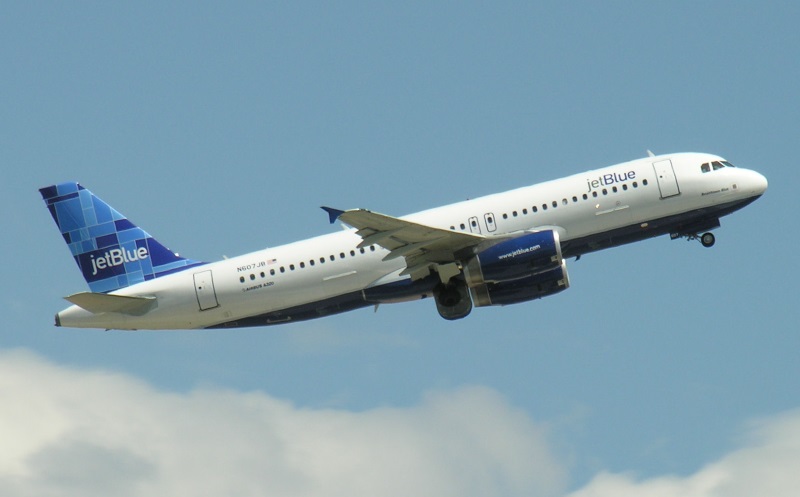
Although Airbus considered using "propfan" propulsion on the A320 -- an engine tinkered with in that era, somewhere in between a fanjet with the cowl removed and a turboprop -- the initial powerplants were CFM56-5-A1 turbofans, providing 112.5 kN (1,135 kgp / 25,000 lbf) each. Later, the International Aero Engines (IAE) V2500 was offered as an option, IAE being a collaboration of Rolls-Royce, Pratt & Whitney, Japanese Aero Engines, Fiat, and MTU. The initial variant was the "V2500-A1", with a thrust of 110 kN (11,340 kgp / 25,000 lbf). A V2500 engine nacelle could be recognized by its smooth rear contour, as opposed to the "stepped" contour of the CFM56. An auxiliary power unit (APU) turbine engine in the tail provided ground and engine starting power.
The A320 had tricycle landing gear, with two wheels on each gear assembly -- the steerable nose gear retracting forward, the main gear pivoting inboard from the wings into the fuselage. A typical seating arrangement was 16 seats, four across, in first class, and 132 seats, six across, in economy, with two lavatories in the rear, and one along with a galley in the front. There were passenger / service doors fore and aft, with twin emergency exits over the wing, on each side of the fuselage. There were cargo bays fore and aft of the wings, with a door to each bay on the right side of the fuselage, with a total capacity of seven LD3-type containers or comparable load. Of course, the jetliner was pressurized and climate-conditioned.
___________________________________________________________________
AIRBUS A320-200:
___________________________________________________________________
wingspan:
34.1 meters (111 feet 11 inches)
wing area:
122.06 sq_meters (1,320 sq_feet)
length:
37.57 meters (123 feet 3 inches)
height:
11.76 meters (38 feet 7 inches)
empty weight:
42,600 kilograms (93,900 pounds)
maximum take-off weight:
78,000 kilograms (172,000 pounds)
max speed at altitude:
870 KPH (535 MPH / 465 KT)
cruise altitude:
12,000 meters (39,000 feet)
range:
5,700 kilometers (3,600 MI / 3,100 NMI)
___________________________________________________________________
The A320 featured a "glass cockpit" with six displays -- two for each pilot, two shared between them in the center of the console -- and featured a "fly by wire" flight control system (FBW FCS), with pilots using sidestick controllers instead of yokes. FBW meant that a pilot could not take the jetliner out of its envelope under reasonable flight conditions; it also supported the automatic LAF turbulence-handling system.
FBW was controversial, with some in the aviation industry upset at the idea of a computer overriding the pilot, but Airbus saw it had tremendous advantages -- though a minimal manual control scheme was added as a backup. There were a few accidents early on that were suspected to be due to FBW, but investigation showed that they were more the fault of aircrew who expected too much of the system; improved training addressed the issue. The A320 also had an "electronic centralized aircraft monitor (ECAM)" system that kept track of the operating condition of its many subsystems.
Production of elements was distributed over facilities in the various Airbus member nations, redundant production being avoided, with final assembly in Toulouse. Oversized assemblies that could not be ground transported were hauled by bulky cargo freight air transports -- initially a number of rather weary Boeing Stratocruiser / Super Guppy turboprop machines, which were soon replaced by the A300-600ST Beluga.
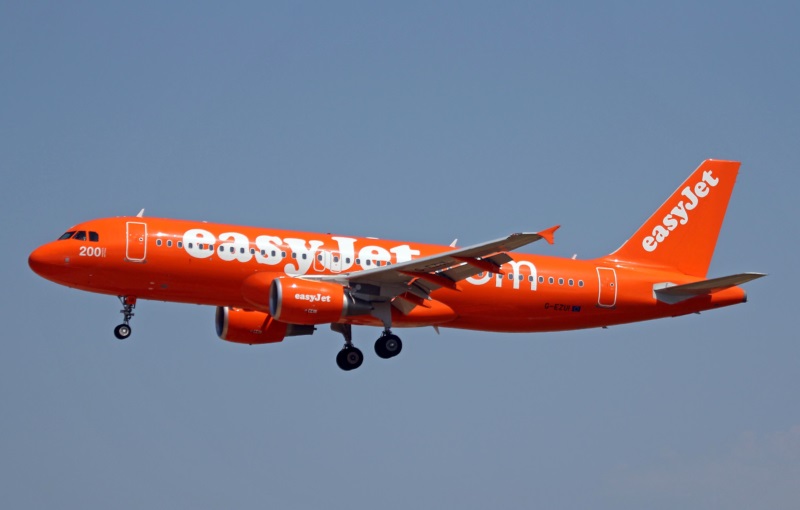
The initial variant of the A320 was the "A320-100", of which only 21 were made, these early machines being distinguished by their lack of wing fences. Production then went on to the "A320-200", with the wing fences, more fuel tankage, and higher maximum take-off weight (MTOW). Indian Airlines obtained a modified set of A320-200 machines with four-wheel main landing gear in a 2x2 bogey configuration, to handle rough fields.
BACK_TO_TOP* Having introduced the A320, Airbus then moved on to a "Stretched A320" derivative with more capacity, with program start in 1988. The A321's primary difference from the A320 were fuselage plugs fore and aft of the wing, which increased the length by 6.94 meters (22 feet 9 inches). MTOW rose accordingly by about 13%, with fuselage and undercarriage reinforced accordingly. Maximum passenger capacity was 220 seats; another galley and lavatory were added, for a total of two and four respectively. Instead of the two overwing emergency exits, doors were fitted fore and aft of the wing. The wing itself was modified, with double slotted flaps replacing Fowler flaps and a reprofiling that added 4 square meters (50 square feet) of area. Initial engine options included the CFM56-5B and V2500-A5.
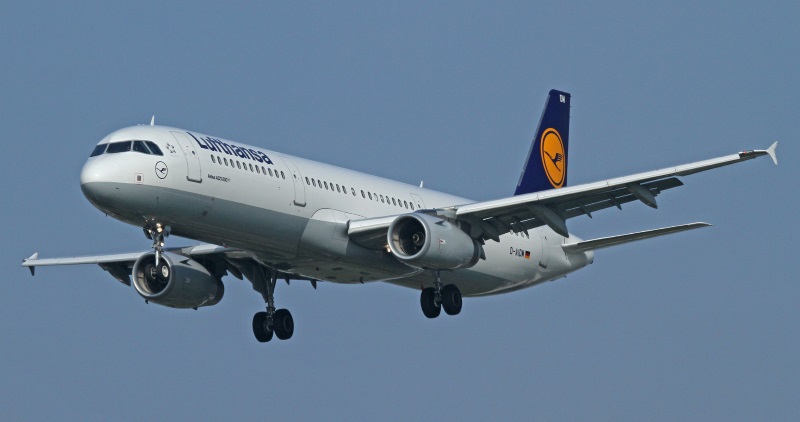
Maiden flight of the first A321 prototype was on 11 March 1993, this machine being powered by V2500 turbofans; it was followed by a second with CFM56-5B engines. After some argument between the Germans and the French, final assembly was placed in Hamburg, making the A321 the first production Airbus machine not rolled out in France. Initial delivery of the A321 was in early 1994, to Lufthansa.
The initial "A321-100" variant had the same fuel tankage as the A320-200 and so, due to the greater weight, had less range. In 1995, Airbus launched the "A321-200", with transcontinental range, thanks to one or two optional fuel tanks in the rear hold. The airframe and landing gear were reinforced to handle the higher MTOW; uprated V2533-A5 or CFM56-5B3 engines were fitted as well.
* Having stretched the A320, Airbus then went on to shrink it, resulting in the "A319", with the fuselage cut down fore and aft of the wing to reduce length by 3.73 meters (12 feet 3 inches). Typical passenger capacity was 124 seats in a two-class configuration, with galley and lavatories as per the A320. Only one emergency exit was placed over each wing instead of two, and the rear cargo bay and its door were smaller. Powerplants were CFM56-5A or V2500-A5 turbofans, derated to 98 kN (9,980 kgp / 22,000 lbf), with an option for 105 kN (10,885 kgp / 24,000 lbf) thrust for "hot & high" service.
Program launch was in 1993, with maiden flight of the first prototype on 25 August 1995. The first prototype had CFM56 powerplants, while the second had V2500 powerplants. Certification was granted in 1996, with initial customer delivery, to Swissair, in the spring. Production was in Hamburg, as with the A320. The A319 actually proved more popular than the A320, with low-cost carrier EasyJet being particularly fond of it.
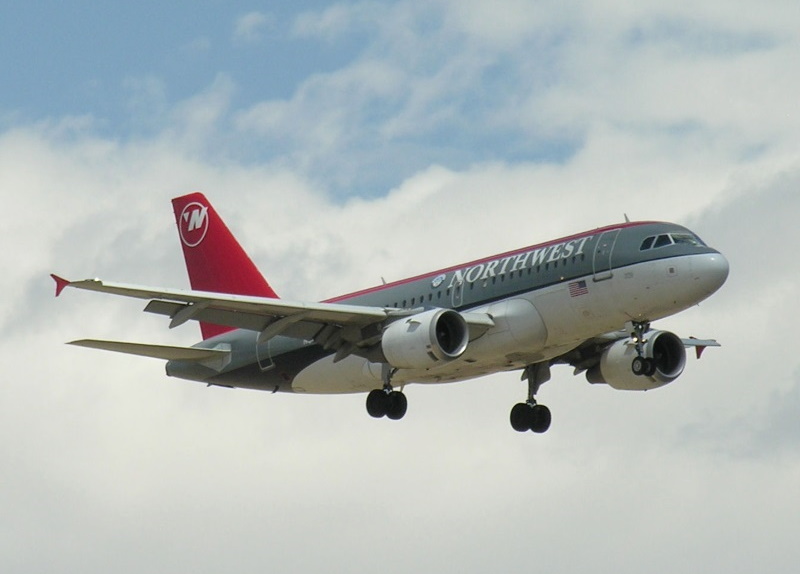
* In 1998, Airbus announced a further cut-down A320 with a nominal passenger load of 100 seats, the length being reduced to 31.44 meters (103 feet 2 inches). Initial flight of the first prototype of the "A318" was in Hamburg on 15 January 2002, Hamburg performing production, and introduction to service in 2003. The A318 was powered by CFM56-5B or Pratt & Whitney (P&W) PW6000 turbofans; it had a taller tail to compensate for the yaw instability caused by the shorter fuselage, giving a height increased from the 11.76 meters (38 feet 7 inches) of the A320 to 12.56 meters (41 feet 2 inches). Actual number of seats was 107 in a two-class layout, with galley and lavatories as per the A320. It didn't prove all that popular, with only 80 sold, and is effectively out of production.
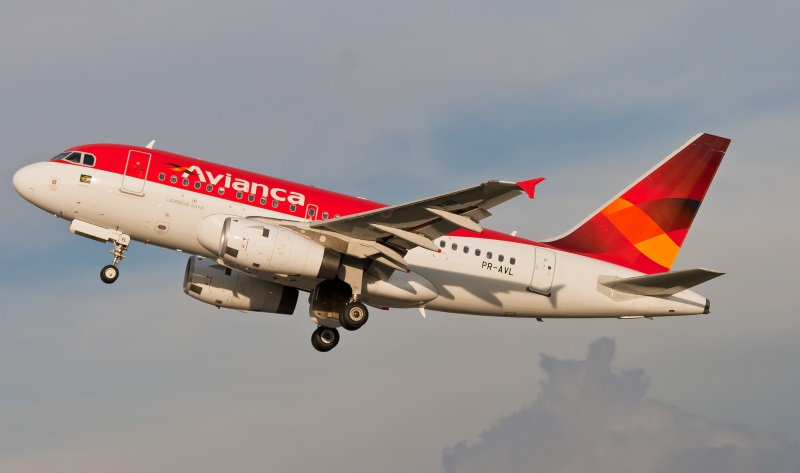
* Of course, Airbus enhanced the A320 series during its production, the result being named the "A320 Enhanced" family. In 2006, work was done on a revised winglet, resulting in a swept winglet of conventional configuration, called a "sharklet", capable of reducing fuel burn by up to 4%. A new cabin was also introduced, with better luggage storage, reduced weight, and lower noise. LED-based lighting was offered as an option; an update program was set up for older machines.
Following the A320 Enhanced, in 2010 Airbus then went on to offer the "A320neo (new engine option)", featuring all the A320 enhancements, plus next-generation engines -- the P&W PW1100G and CFM International LEAP-1A -- offering lower maintenance costs and about 15% better fuel economy, translating to an increment of range of 950 kilometers (590 miles / 510 NMI) or increment of payload of two tonnes (4,400 pounds). Earlier A320 models were described as the "A320ceo (current engine option)". Virgin America was the launch customer for the A320neo.
The first of four A320neo prototypes was rolled out in the summer of 2014, this machine being powered by PW1100G engines, with initial flight on 24 September. It was followed by a second prototype with P&W engines; and then a third, with LEAP-1A engines, this aircraft performing its initial flight on 19 May 2015. A second LEAP-1A prototype followed. The A320neo entered service with Lufthansa in early 2016.
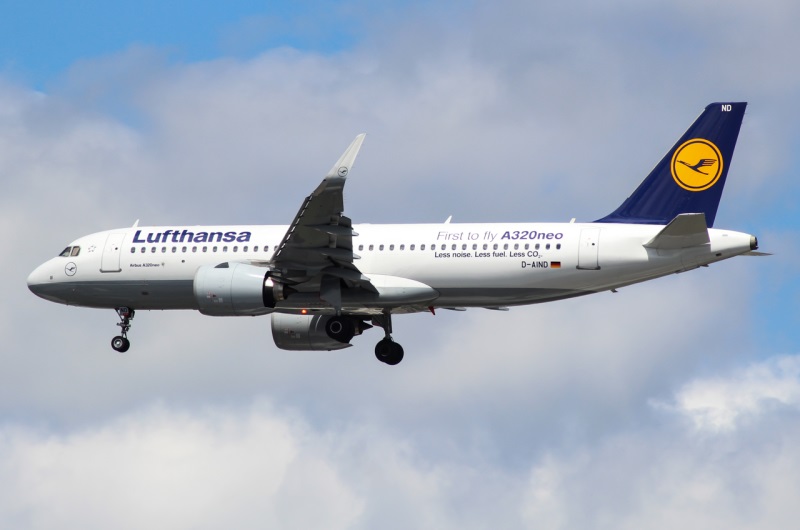
The A320neo was followed by the "A319neo" and "A321neo". The A321neo was the first to fly, a prototype fitted with LEAP-1A engines taking to the skies on 9 February 2016, being followed the next year by a second prototype with PW1100G engines . The A321neo not only has the new engines, but has a rearranged door configuration -- no forward door; two overwing exits, one being plugged for low-density seating arrangements; and the rear door moved back -- to permit 20 more passengers, for a load of 240. Service entry was delayed by engine problems to well into 2018.
First flight of the sole A319neo prototype was on 31 March 2017, this machine initially being powered by LEAP-1A engines, later by PW1100G engines. Deliveries began in 2019; customer interest was soft, which is presumably why only a single prototype was flown.
A long-range "A321LR" variant of the A321neo performed its initial flight in early 2018, going into service later in the year. This variant had more fuel tankage, higher MTOW, and a passenger capacity of 206 seats -- 16 business, 190 economy, with the greater capacity achieved by rearranging the cabin layout. It had a range of 7,400 kilometers (4,595 miles / 4,000 NMI), 25% more than the A321neo. An "A321XLR" with further increased range -- 8,325 kilometers (5,170 miles / 4,500 NMI) -- is in the works, with initial flight in 2022 and introduction to service in 2023.
* Airbus offers corporate / VIP configurations of the A320 series jetliners under the "Airbus Corporate Jet (ACJ) label, with designations such as "ACJ320", "ACJ320neo", and so on -- featuring luxury interiors as per customer spec, and options such as long-range tanks. The A320 series is also in use with a good number of armed services in the personnel and VIP transport roles.
However, their use in the "special missions" role was slow to take off. One of the first examples was an Airbus A319 obtained by the Luftwaffe -- German Air Force -- in 2019 that was modified to support the "Open Skies" arms-control effort, in which Western aircraft were allowed to observe sites in Russia, and the reverse, to ensure adherence to arms-control treaties.
The "A319 OH (Offener Himmel / Open Skies)" aircraft had been in commercial service, being refurbished for the surveillance role. The primary change was installation of a day-night electro-optical imaging system. However, the US withdrew from the Open Skies Treaty in 2020, citing a lack of cooperation with the Russians, with the Russians pulling out the next year. It is not clear if the A319 OH still has a mission.
More significantly, India's Defense Research & Development Organization (DRDO) displayed an advanced airborne early warning and control (AEW&C) platform, obtaining six used A321s for the role. These "AEW&C Mk.2" machines will follow the "AEW&C Mk.1" platforms -- which were three Embraer ERJ-145 regional jets carrying a DRDO-developed active-array radar in a beam over the spine of the aircraft. Schedule for introduction of the AEW&C Mk.2 is unclear.
The French and Germans are now working on a "Maritime Airborne Weapons System (MAWS)" program to replace the French Breguet Atlantique 2 and German Lockheed P-3C Orion patrol aircraft, with service entry in the next decade. Airbus has proposed an "A320 Maritime Patrol Aircraft (MPA)", as a facet of an "A320 Modular Multi-Mission Aircraft (M3A)" -- which as its name implies, will allow it to be used for other military missions, such as signals intelligence or battlefield surveillance.
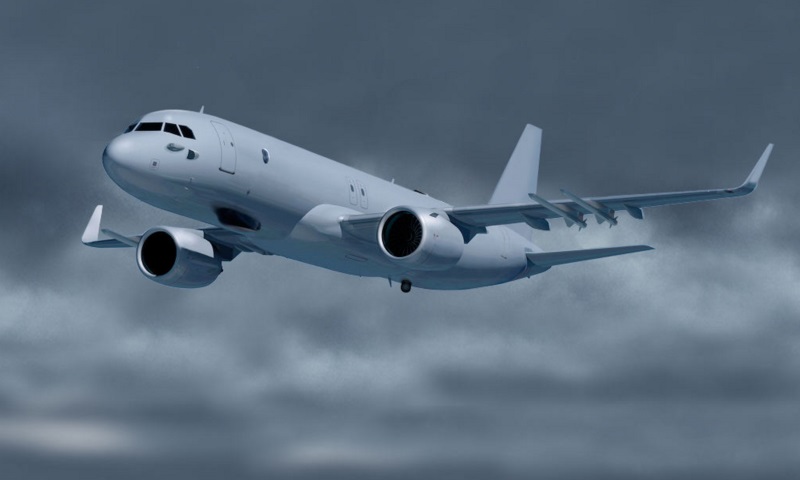
From 2009, a plant in Tianjin, China, has been producing A320-series jetliners for the Chinese market. In 2013, Airbus began work on another production facility in Mobile, Alabama, which opened in 2015, with the first US-built machine, an A321, delivered in the spring of 2016. One of the motives in establishing production facilities outside of Europe was that it is hard to lay off workers in Europe, and having factories where employees could be more easily dismissed gave Airbus greater workforce flexibility in the event of an order shortfall.
As of early 2019, over 8,600 A320-series jetliners had been delivered. The A320neo is likely to replace existing A320-series jetliners in service. In consequence, following an earlier false start, in 2015 Airbus signed an agreement with Singapore-based ST Aerospace to offer passenger-to-freighter (P2F) conversions of existing A320 and A321 jetliners. The "A320P2F" will be able to haul 21 tonnes (23 tons) of cargo over 3,885 kilometers (2,415 miles / 2,100 NMI), while the "A321P2F" will be able to haul 27 tonnes (30 tons) of cargo over 3,515 kilometers (2,185 miles / 1,900 NMI). The first conversions were delivered in 2018, with Airbus officials estimating there will be hundreds more.
BACK_TO_TOP* Airbus chose to develop the smaller A320 to complement the A300-series of jetliners; in 1988, investigation began of a bigger "Ultra-High Capacity Aircraft (UHCA)" as well, initially designated the "A3XX". Full go-ahead for development was given in 1999, with official program launch of the "A380", as it was formally designated, in 2000.
The first of five A380 prototypes performed its initial flight on 27 April 2005; the flight was like an airshow in itself, with a crowd of over 50,000 in attendance. There were no problems, and the aircraft's handling proved excellent. Five prototypes were built to support the development program. Initial certification was in early 2006, with the A380 entering service in 2007 with Singapore Airlines. Final assembly is in Toulouse.
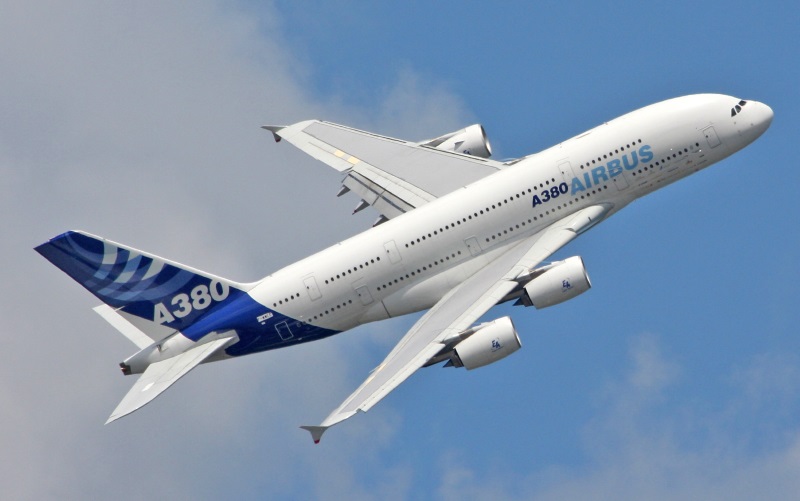
As it emerged, the A380 was a widebody, double-deck aircraft, with a total floor space of 478 square meters (5,145 square feet) -- 40% more than the next biggest jetliner, the Boeing 747-8. Construction was mostly of aircraft aluminum alloy, though with a high proportion of composites. The A380 was available with two types of engines, the Rolls-Royce Trent 900 or the Engine Alliance GP7000, with thrust level on the order of 336 kN (36,280 kgp / 80,000 lbf) -- varying below or above that level as per engine variant. Only the inboard engines had thrust reversers. A PW 980A APU provided ground and starting power.
Wing sweep at quarter chord was 35 degrees 44 seconds inboard, 34 degrees 28 seconds outboard. The tailfin had a sweep of 40 degrees at quarter-chord. Each wing featured single slotted flaps in three segments; seven spoilers in front of the flaps; an aileron in three segments; leading-edge slats in eight segments; and wing fences along the lines of those of the A320. Along with a single nosewheel assembly, there were four main gear assemblies, with six wheels each in a 2x3 bogey arrangement. The steerable nose gear retracted forward; the outboard main gear hinged in towards the fuselage, while the inboard main gear, to the rear of the outboard gear, retracted backward.
The lower deck accommodated row widths of up to ten seats, while the upper deck could accommodate row widths of up to eight seats. Typical three-class capacity was 525 seats; maximum capacity, in a one-class configuration, is 853 seats. In a typical configuration, the lower deck would have:
The upper deck would have:
First-class passenger configurations would often include fancy fixtures and luxuries -- a parody of an A380 layout for Virgin America featured a casino, a zoo, a bowling alley, a morgue, and 550 economy seats on a 25-centimeter (ten-inch) pitch.
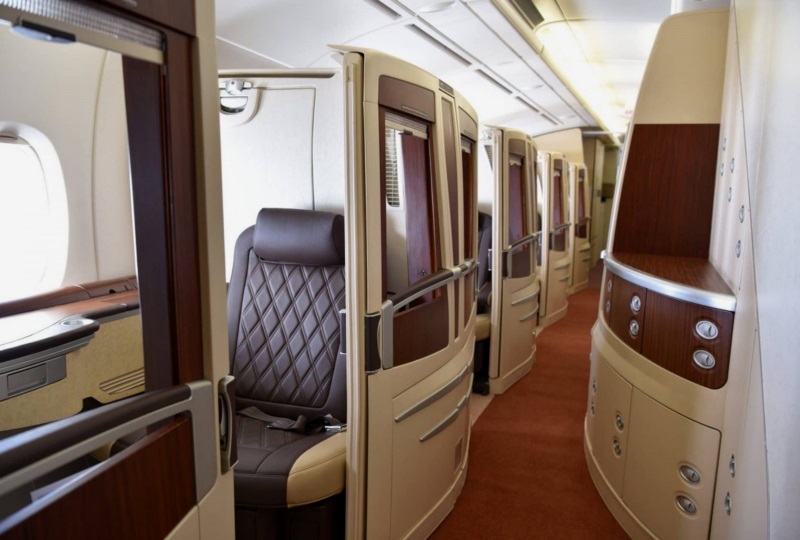
The passenger cabin was designed to reduce fatigue, with lower noise levels and higher pressurization than earlier jetliners. The windows were also larger, there was more headroom, as well as bigger overhead bins. Lighting was provided by a system of LED lamps that can be programmed to simulate daytime, night, or intermediate levels. There were stairways fore and aft to connect the upper and lower decks. Each side of the aircraft featured five doors / emergency exits on the lower deck, three on the upper deck. The cargo hold in the belly of the aircraft could accommodate 38 standard LD3 cargo containers, or a load equivalent.
___________________________________________________________________
AIRBUS A380-800:
___________________________________________________________________
wingspan:
79.75 meters (238 feet 7 inches)
wing area:
845 sq_meters (9,100 sq_feet)
length:
72.73 meters (238 feet 7 inches)
height:
24.45 meters (80 feet 3 inches)
empty weight:
276,800 kilograms (610,200 pounds)
MTO weight:
575,000 kilograms (1,272,000 pounds)
max cruise speed:
945 KPH (585 MPH / 510 KT)
cruise altitude:
13,135 meters (43,100 feet)
range:
15,700 kilometers (9,755 MI / 8,500 NMI)
___________________________________________________________________
The A380 featured contemporary avionics, including radios, identification transponder, landing and navigation aids (with GPS), color weather radar, and a networked interconnection scheme. Cameras were fitted under the fuselage and on top of the tailfin to aid in taxiing. The jetliner had a glass cockpit with eight color flat-panel displays, and was flown with sidestick controllers.
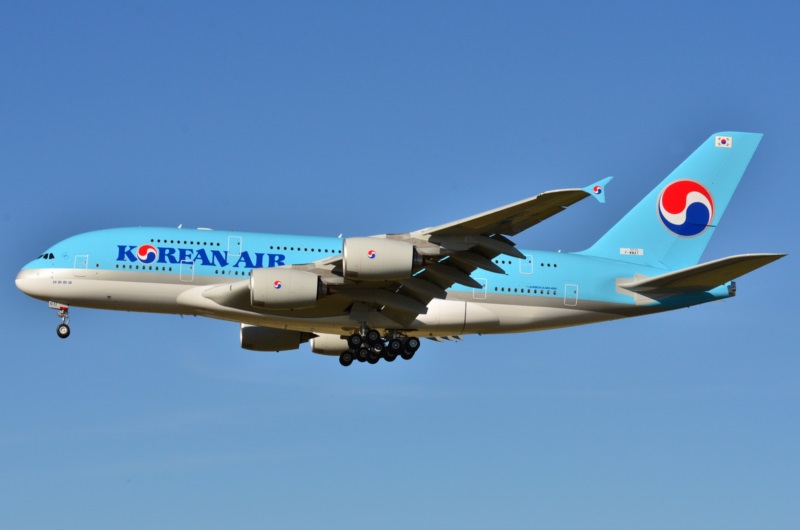
Aircrew found the A380's handling very benign. However, it did complicate the lives of airport flight controllers, since its powerful wake vortex meant that smaller jetliners couldn't fly any closer than 13 kilometers (7 NMI) behind it. Running into things while taxiing was also a greater concern, since there was so much more aircraft there to run into things. There were a few unfortunate incidents, leading to talk of wingtip collision-warning systems, based on automotive radars.
A higher MTOW version, featuring various tweaks, went into production in 2010, with further raises in MTO following. There were also tweaks in A380 avionics, aerodynamics, engines, and airframe over its evolution. An "ACJ380" corporate / VIP configuration was on order, but not too surprisingly, nobody bit on it. In late 2014, Airbus CEO Fabrice Bergier announced that the firm would (eventually) introduce an "A380neo", with Airbus officials later adding that an updated A380 might well also feature a fuselage stretch of about 6 meters -- 20 feet, enough for six rows on both the decks, or about 100 more passengers, while increasing the empty weight by only about 5%.
No commitments or dates were given, and some industry observers were skeptical that the economics made any sense. They didn't. Following a disappointing collapse of sales, Airbus announced in 2019 that it would complete existing A380 orders and end production. Indeed, from early 2020, the COVID-19 pandemic had a drastic effect on air travel, particularly internationally. Air France abandoned the A380 in May 2020, two years ahead of plan, while other A380 operators scaled back. The last A380 was delivered in December 2021. At the outset, Airbus had projected sales of 1,500 A380s; the end tally was 251.
The A380 is in terminal decline, but it is still flying with a number of airlines, and Airbus using it for a testbed, one project being to test an electric-drive prop, powered by a hydrogen fuel cell system -- the "zero-emissions" engine being named the "ZEROe Fuel Cell Engine". The engine will be mounted on a stub pylon along the rear fuselage. Flight tests are expected from 2026.
BACK_TO_TOP* The Airbus A300 series was showing its age by the turn of the century, and so in 2004 Airbus began work on a replacement, the "A350". The original concept used a fuselage design leveraged off the A300 -- but customer feedback dictated a greater break from the past, with the design reconsidered in 2006 and given the designation of "A350 Extra Wide Body (XWB)". Qatar Airways became the launch customer. Initial flight of the baseline "A350-900" was on 14 June 2013, with certification the next year.
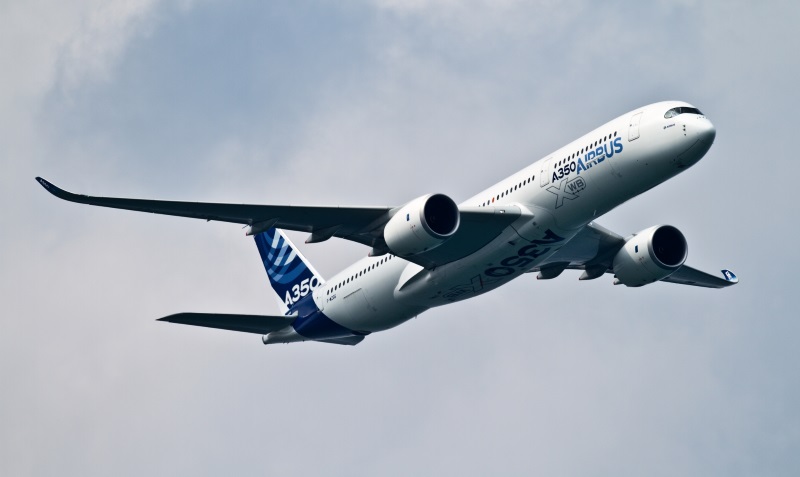
As it emerged, the A350 -- since there was no production variant of the original A350 concept, the XWB is usually left implied -- had a configuration along the lines of the A300-series jetliners, but was of largely composite construction; the wings featured neatly curved winglets. The baseline powerplant was the Trent XWB; alternative engine offerings from GE and P&W were to be considered in time. Engine start and backup power was provided by a Honeywell HGT1700 APU. The A350 featured a glass cockpit with six displays. The nose gear had two wheels, while the main gear typically had four wheels in a 2x2 bogey arrangement, with six wheels in a 2x3 bogey arrangement provided on high-MTOW variants. The nose gear retracted forward, the main gear pivoted inward into the fuselage.
___________________________________________________________________
AIRBUS A350-900:
___________________________________________________________________
wingspan:
64.8 meters (213 feet)
wing area:
460 sq_meters (5,000 sq_feet)
length:
66.89 meters (219 feet 6 inches)
height:
17.05 meters (55 feet 11 inches)
empty weight:
115,700 kilograms (255,100 pounds)
MTO weight:
268,000 kilograms (591,000 pounds)
max cruise speed:
945 KPH (585 MPH / 510 KT)
cruise altitude:
13,135 meters (43,100 feet)
range:
14,350 kilometers (8,912 MI / 7,750 NMI)
___________________________________________________________________
Economy seating arrangements featured from 8 to 10 seats across in a two-aisle configuration. Passenger accommodations featured large windows, LED lighting, and a fiber-optic network for entertainment distribution. Airbus officials claimed the A350 was more efficient in terms of passenger-miles than the competing Boeing 787, an assertion that Boeing of course energetically disputed. Impartial observers noted that Airbus had often sniped at the "all-composite" construction of the 787, until Airbus began work on their own such aircraft -- Airbus and Boeing rarely have much good to say about each other, and so customers don't take their shots at each other very seriously.
The A350-900 had a range of 13,900 kilometers (8,625 miles / 7,500 NMI) and a typical passenger capacity of 314 seats in a three-class configuration, with 9-across seating in economy class. It had four doors along each side of the fuselage, plus cargo doors on the right side of the fuselage, one fore and aft of the wing. It was powered by the baseline Trent XWB engine, with a thrust of 370 kN (37,640 kgp / 83,000 lbf).
Airbus also developed an "A350-900ULR" ultra-long-range subvariant for Singapore Airlines, to support the Singapore-to-New York route, with initial flight in the spring of 2018, and deliveries later in that year. SAL had originally used the four-engine A340 on that route, but it wasn't cost-effective, and so SAL gave up the service until the ULR machines arrived. An "ACJ350" corporate / VIP version, based on the A350-900ULR, is also on offer.
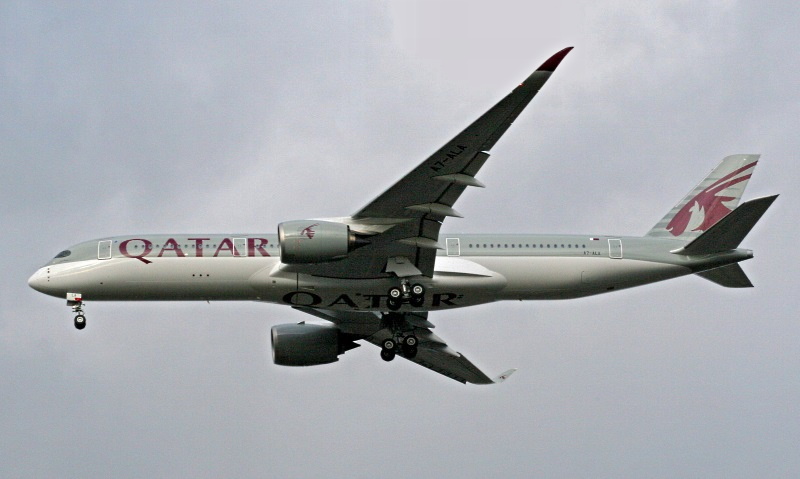
The A350-900 was to be followed by the "A350-800", a "shortened" version, with length reduced to 90% of the -900; but due to lack of adequate customer interest, the A350-800 was canceled. Work continued on the stretched "A350-1000", with length increased to 110% (73.88 meters / 242 feet 5 inches) of the -900 and MTOW raised to 115% (308 tonnes / 339 tons). Initial flight of the first of three A350-1000 prototypes was on 24 November 2016; certification was awarded in late 2017, with customer deliveries following in 2018, the launch customer being Qatar Airways.
The A350-1000 had a passenger capacity of 350 seats in a three-class configuration; it featured a slightly bigger wing, and was powered by uprated Trent XWB-97 turbofans with 432 kN (43,990 kgp / 97,000 lbf) thrust each. An "A350F" freighter based on the A350-1000 was announced in 2021, with deliveries planned for 2025. There was consideration of a further stretched "A350-2000", but Airbus officials concluded there was no real demand for it in the present.
* In the fall of 2022, Airbus introduced a set of enhancements for the A350 product line, including:
There is also more general work under the "Dragonfly" research program, focused on improvements in flight automation across the Airbus airliner family, including automated emergency diversion in cruise, along with automatic landing and taxi assistance. These improvements are likely to be added in software updates for both aircraft and ground systems.
BACK_TO_TOP* In 2008, the Bombardier company of Canada, best known for its business jets, announced the development of a new "regional jet" named the "CSeries", which was initially to consist of a 108:133-seat "CS100" and a 130:160-seat "CS300". Then politics intervened. In 2017, the incoming Trump Administration, at the instigation of Boeing, contemplated slapping punitive tariffs on the CSeries. That didn't happen, but the exercise led to Airbus buying up a majority share in Bombardier, with the CSeries then becoming the "Airbus A220", and the two variants becoming the "A220-100" and "A220-300".
Initial flight of the first of six A220-100 (CS100) test aircraft was on 16 September 2013, with certification in late 2015, and service entry in mid-2016. Initial flight of the first of two A220-300 (CS300) test aircraft was on 28 February 2015, with certification in mid-2016, and service entry before the end of the year.
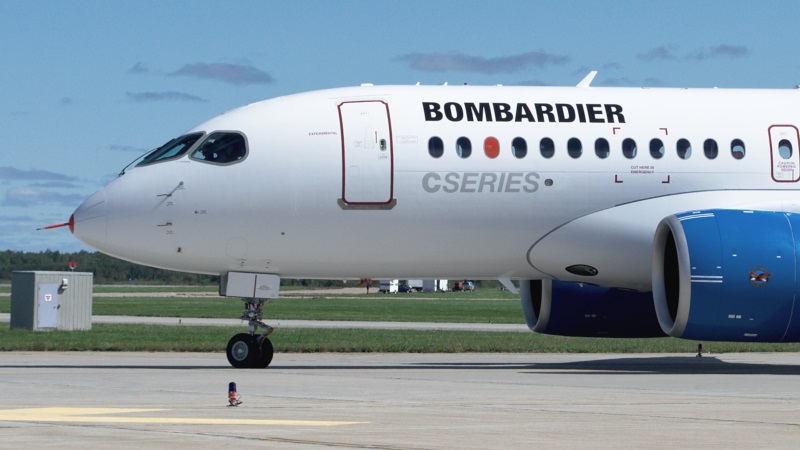
The A220, as introduced, was powered by the highly efficient Pratt & Whitney PW1500G geared turbofan, and made extensive use of composite materials, plus aluminum-lithium alloy as well as some titanium, in its construction. The aircraft had a digital fly-by-wire flight control system; a health-monitoring system; and a Rockwell Collins Pro Line Fusion avionics system, with a five-panel glass cockpit.
The A220-100 was powered by twin PW1519G engines with 84.1 kN (8,570 kgp / 18,900 lbf). The A220-300 was powered by PW1521G engines with 93.4 kN (9,250 kgp / 21,000 lbf) thrust each -- alternative powerplants being the PW1524G or PW1525G with 103.6 kN (10,565 kgp / 23,300 lbf) each.
___________________________________________________________________
AIRBUS (BOMBARDIER) A220-100:
___________________________________________________________________
wingspan:
35.1 meters (115 feet 1 inch)
wing area:
112 sq_meters (1,209 sq_feet)
length:
35 meters (114 feet 9 inches)
height:
11.5 meters (37 feet 8 inches)
empty weight:
50,350 kilograms (111,000 pounds)
MTO weight:
60,780 kilograms (134,000 pounds)
max cruise speed:
870 KPH (540 MPH / 470 KT)
service ceiling:
12,495 meters (41,000 feet)
range:
5,471 kilometers (3,565 MI / 3,100 NMI)
___________________________________________________________________
Span and height of the A220-300 were the same, but length was extended to 38.7 meters (127 feet), with weight increased by about 10%, and range increased by about 5%.
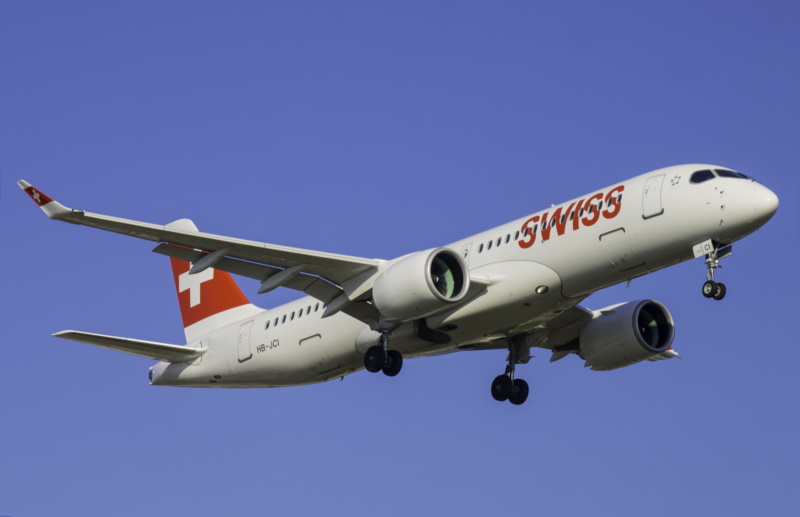
There was talk of introducing extended range (XR) versions of both variants, but the decision was made to drop the shorter-range configuration and make the XR configuration standard. An option for further enhanced range -- stretched by 833 kilometers (520 mi / 450 NMI), with corresponding increase in MTOW -- was introduced in 2019.
An Airbus Corporate Jet configuration, the "ACJ Two-Twenty", based on the A220-100, is on offer, with VIP interiors with six living spaces, and range of 10,460 km (6,500 mi / 5,650 NMI) -- enough for a London to Los Angeles flight. Initial flight was in December 2021. There's also talk of a stretched "A220-500", with 150 seats and extended range, but no commitment yet.
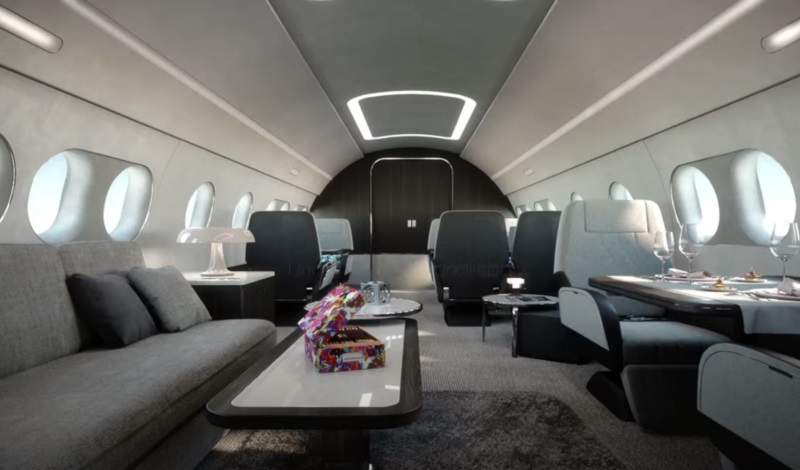
Bombardier found the CSeries program tough going; Airbus seems determined to make a go of it. A220s for the US market are being assembled at the Airbus plant in Mobile, Alabama, with the "Made In America" label giving them protection from further tariff wars.
BACK_TO_TOP* Sources include:
The Airbus website, the online Wikipedia, and several volumes of JANE'S ALL THE WORLD AIRCRAFT were also consulted for details.
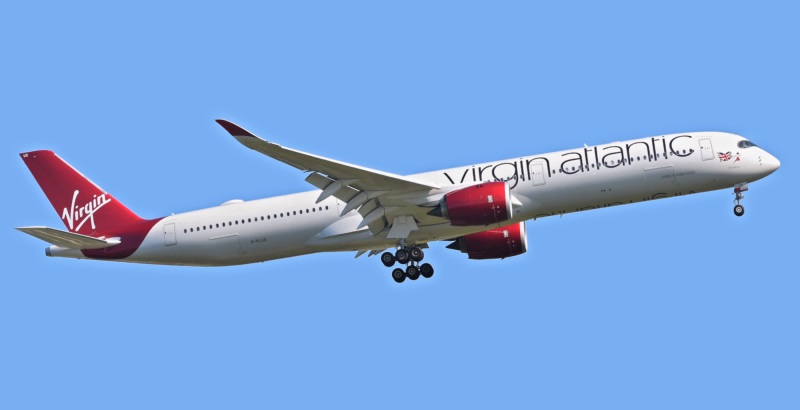
* Illustrations details:
* Revision history:
v1.0.0 / 01 jul 14 v1.0.1 / 01 jun 16 / Taller tailfin on A318, minor updates. v1.0.2 / 01 may 18 / Review, update, & polish. v2.0.0 / 01 apr 20 / Added A220. v2.1.0 / 01 apr 22 / Updates, added illustrations. v2.2.0 / 01 mar 24 / Review, update, & polish.BACK_TO_TOP
